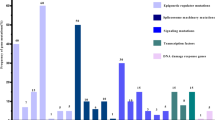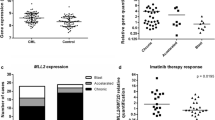Abstract
SET and MYND domain containing 2 (SMYD2) and the SET and MYND domain containing 3 (SMYD3) are the most studied and well-characterized members of SMYD family. It has been demonstrated that their altered expression is associated with the progression of several solid tumors. Nevertheless, whether these methyltransferases exert any impact in chronic lymphocytic leukemia (CLL) remains unknown. Here, we investigated the gene expression profile of SMYD2 and SMYD3 in 59 samples of CLL and 10 normal B cells. The obtained results were associated with white blood cells (WBC) and platelet counts, ZAP-70 protein expression, and cytogenetic analysis. We found that SMYD2 and SMYD3 are overexpressed in CLL patients and, interestingly, patients with residual expression of both genes presented a high WBC count and complex karyotype. Furthermore, a strong correlation between SMYD2 and SMYD3 gene expression was unveiled. Our data demonstrate the association of a residual expression of SMYD2 and SMYD3 with CLL progression indicators and suggests both genes are regulated by a common transcriptional control in this type of cancer. These results may provide the basis for the development of new therapeutic strategies to prevent CLL progression.




Similar content being viewed by others
References
Zenz T, Mertens D, Küppers R, Döhner H, Stilgenbauer S. From pathogenesis to treatment of chronic lymphocytic leukaemia. Nat Rev Cancer. 2010;10:37–50. [Internet] Available from: http://dx.doi.org/10.1038/nrc2764.
Gribben JG. How I, treat CLL up front. Blood. 2010;115:187–97.
Wiestner A. Emerging role of kinase-targeted strategies in chronic lymphocytic leukemia. Blood. 2012;120:4684–91.
Burger JA, Ghia P, Rosenwald A, Caligaris-Cappio F. The microenvironment in mature B-cell malignancies: a target for new treatment strategies. Blood. 2009;114:3367–75.
De Paula Careta F, Gobessi S, Panepucci RA, Bojnik E, de Morato Oliveira F, Mazza Matos D, et al. The Aurora A and B kinases are up-regulated in bone marrow-derived chronic lymphocytic leukemia cells and represent potential therapeutic targets. Haematologica. 2012;97:1246–54. [Internet] Available from: http://www.pubmedcentral.nih.gov/articlerender.fcgi?artid=3409824&tool=pmcentrez&rendertype=abstract.
Moreno C, Montserrat E. New prognostic markers in chronic lymphocytic leukemia. Blood Rev. 2008;22:211–9. [Internet] Available from: http://www.sciencedirect.com/science/article/pii/S0268960X08000210.
Binet JL, Auquier A, Dighiero G, Chastang C, Piguet H, Goasguen J, et al. A new prognostic classification of chronic lymphocytic leukemia derived from a multivariate survival analysis. Cancer. 1981;48:198–206.
Rai KR, Sawitsky A, Cronkite EP, Chanana AD, Levy RN, Pasternack BS. Clinical staging of chronic lymphocytic leukemia. Blood. 1975;46:219–34. [Internet] Available from: http://www.bloodjournal.org/content/46/2/219.abstract.
Van Bockstaele F, Verhasselt B, Philippé J. Prognostic markers in chronic lymphocytic leukemia: a comprehensive review. Blood Rev. 2009;23:25–47.
Sagatys EM, Zhang L. Clinical and laboratory prognostic indicators in chronic lymphocytic leukemia. Cancer Control. 2012;19:18–25. [Internet] Available from: http://www.ncbi.nlm.nih.gov/pubmed/22143059.
Rosenquist R, Cortese D, Bhoi S, Mansouri L, Gunnarsson R. Prognostic markers and their clinical applicability in chronic lymphocytic leukemia: where do we stand? Leuk Lymphoma. 2013;54:2351–64. [Internet] Available from: http://www.ncbi.nlm.nih.gov/pubmed/23480493.
Foà R, Del Giudice I, Guarini A, Rossi D, Gaidano G. Clinical implications of the molecular genetics of chronic lymphocytic leukemia. Haematologica. 2013;98:675–85.
Gunnarsson R, Mansouri L, Rosenquist R. Exploring the genetic landscape in chronic lymphocytic leukemia using high-resolution technologies. Leuk Lymphoma. 2013;54:1583–90. [Internet] Available from: http://www.ncbi.nlm.nih.gov/pubmed/23167608.
Kudithipudi S, Jeltsch A. Role of somatic cancer mutations in human protein lysine methyltransferases. Biochim Biophys Acta. 2014;1846:366–79. [Internet] Available from: http://www.sciencedirect.com/science/article/pii/S0304419X14000754\n http://www.ncbi.nlm.nih.gov/pubmed/25123655.
Lund K, Adams PD, Copland M. EZH2 in normal and malignant hematopoiesis. Leukemia. 2014;28:44–9. [Internet] Available from: http://www.ncbi.nlm.nih.gov/pubmed/24097338.
Liu L, Kimball S, Liu H, Holowatyj A, Yang Z-Q. Genetic alterations of histone lysine methyltransferases and their significance in breast cancer. Oncotarget. 2015;6:2466–82.
Rabello DDA, Lucena-Araujo AR, Alves-Silva JCR, da Eira VBAS, de Vasconcellos MCC, de Oliveira FM, et al. Overexpression of EZH2 associates with a poor prognosis in chronic lymphocytic leukemia. Blood Cells Mol Dis. 2014;54:97–102. [Internet]. Available from: http://www.ncbi.nlm.nih.gov/pubmed/25131810.
Béguelin W, Popovic R, Teater M, Jiang Y, Bunting KL, Rosen M, et al. EZH2 is required for germinal center formation and somatic EZH2 mutations promote lymphoid transformation. Cancer Cell. 2013;23:677–92. [Internet] Available from: http://www.pubmedcentral.nih.gov/articlerender.fcgi?artid=3681809&tool=pmcentrez&rendertype=abstract.
Visser HP, Gunster MJ, Kluin-Nelemans HC, Manders EM, Raaphorst FM, Meijer CJ, et al. The polycomb group protein EZH2 is upregulated in proliferating, cultured human mantle cell lymphoma. Br J Haematol. 2001;112:950–8. [Internet] Available from: http://www.ncbi.nlm.nih.gov/pubmed/11298590.
Morin RD, Johnson NA, Severson TM, Mungall AJ, An J, Goya R, et al. Somatic mutations altering EZH2 (Tyr641) in follicular and diffuse large B-cell lymphomas of germinal-center origin. Nat Genet. 2010;42:181–5. [Internet] Available from: http://www.pubmedcentral.nih.gov/articlerender.fcgi?artid=2850970&tool=pmcentrez&rendertype=abstract.
Sasaki D, Imaizumi Y, Hasegawa H, Osaka A, Tsukasaki K, Lim Choi Y, et al. Overexpression of enhancer of zeste homolog 2 with trimethylation of lysine 27 on histone H3 in adult T-cell leukemia/lymphoma as a target for epigenetic therapy. Haematologica. 2011;96:712–9.
Sakamoto LHT, De Andrade RV, Felipe MSS, Motoyama AB, Pittella Silva F. SMYD2 is highly expressed in pediatric acute lymphoblastic leukemia and constitutes a bad prognostic factor. Leuk Res. 2014;38:496–502. [Internet]. Available from: http://dx.doi.org/10.1016/j.leukres.2014.01.013.
Hamamoto R, Furukawa Y, Morita M, Iimura Y, Silva FP, Li M, et al. SMYD3 encodes a histone methyltransferase involved in the proliferation of cancer cells. Nat Cell Biol. 2004;6:731–40.
Trievel RC, Beach BM, Dirk LMA, Houtz RL, Hurley JH. Structure and catalytic mechanism of a SET domain protein methyltransferase. Cell. 2002;111:91–103.
Zhang X, Tamaru H, Khan SI, Horton JR, Keefe LJ, Selker EU, et al. Structure of the Neurospora SET domain protein DIM-5, a histone H3 lysine methyltransferase. Cell. 2002;111:117–27. [Internet] Available from: http://www.pubmedcentral.nih.gov/articlerender.fcgi?artid=2713760&tool=pmcentrez&rendertype=abstract.
Veraksa A, Kennison J, McGinnis W. DEAF-1 function is essential for the early embryonic development of Drosophila. Genesis. 2002;33:67–76. [Internet] Available from: http://www.ncbi.nlm.nih.gov/pubmed/12112874.
Silva FP, Hamamoto R, Kunizaki M, Tsuge M, Nakamura Y, Furukawa Y. Enhanced methyltransferase activity of SMYD3 by the cleavage of its N-terminal region in human cancer cells. Oncogene. 2008;27:2686–92. [Internet] Available from: http://www.ncbi.nlm.nih.gov/pubmed/17998933.
Komatsu S, Ichikawa D, Hirajima S, Nagata H, Nishimura Y, Kawaguchi T, et al. Overexpression of SMYD2 contributes to malignant outcome in gastric cancer. Br J Cancer. 2015;112:357–64. [Internet] Available from: http://dx.doi.org/10.1038/bjc.2014.543.
Hamamoto R, Silva FP, Tsuge M, Nishidate T, Katagiri T, Nakamura Y, et al. Enhanced SMYD3 expression is essential for the growth of breast cancer cells. Cancer Sci. 2006;97:113–8. [Internet]. Available from: http://www.ncbi.nlm.nih.gov/pubmed/16441421.
Hu L, Zhu YT, Qi C, Zhu Y-J. Identification of Smyd4 as a potential tumor suppressor gene involved in breast cancer development. Cancer Res. 2009;69:4067–72. [Internet]. Available from: http://www.ncbi.nlm.nih.gov/pubmed/19383909.
Matutes E, Owusu-Ankomah K, Morilla R, Garcia Marco J, Houlihan A, Que TH, et al. The immunological profile of B-cell disorders and proposal of a scoring system for the diagnosis of CLL. Leuk Off J Leuk Soc Am Leuk Res Fund, UK. 1994;8:1640–5.
Pfaffl MW. A new mathematical model for relative quantification in real-time RT-PCR. Nucleic Acids Res. 2001;29, e45. [Internet] Available from: http://www.ncbi.nlm.nih.gov/pubmed/11328886.
Molica S, Alberti A. Prognostic value of the lymphocyte doubling time in chronic lymphocytic leukemia. Cancer. 1987;60:2712–6.
Hallek M, Cheson BD, Catovsky D, Caligaris-Cappio F, Dighiero G, Dohner H, et al. Guidelines for the diagnosis and treatment of chronic lymphocytic leukemia: a report from the International Workshop on Chronic Lymphocytic Leukemia updating the National Cancer Institute-Working Group 1996 guidelines. Blood. 2008;111:5446–56. [Internet] Available from: http://www.ncbi.nlm.nih.gov/pubmed/18216293.
Moon RT, Kohn AD, De Ferrari GV, Kaykas A. WNT and beta-catenin signalling: diseases and therapies. Nat Rev Genet. 2004;5:691–701.
Gandhirajan RK, Poll-Wolbeck SJ, Gehrke I, Kreuzer K. Wnt/β-catenin/LEF-1 signaling in chronic lymphocytic leukemia (CLL): a target for current and potential therapeutic options. Curr Cancer Drug Targets. 2010;10:716–27. [Internet] Available from: http://www.ncbi.nlm.nih.gov/pubmed/20578984.
Döhner H, Stilgenbauer S, Benner A, Leupolt E, Kröber A, Bullinger L, et al. Genomic aberrations and survival in chronic lymphocytic leukemia. N Engl J Med. 2000;343:1910–6.
Mayr C, Speicher MR, Kofler DM, Buhmann R, Strehl J, Busch R, et al. Chromosomal translocations are associated with poor prognosis in chronic lymphocytic leukemia. Blood. 2006;107:742–51. [Internet] Available from: http://www.ncbi.nlm.nih.gov/pubmed/16179374.
Huang J, Perez-Burgos L, Placek BJ, Sengupta R, Richter M, Dorsey JA, et al. Repression of p53 activity by Smyd2-mediated methylation. Nature. 2006;444:629–32. [Internet] Available from: http://www.ncbi.nlm.nih.gov/pubmed/17108971.
Thompson SL, Compton DA. Proliferation of aneuploid human cells is limited by a p53-dependent mechanism. J Cell Biol. 2010;188:369–81.
Fujiwara T, Bandi M, Nitta M, Ivanova EV, Bronson RT, Pellman D. Cytokinesis failure generating tetraploids promotes tumorigenesis in p53-null cells. Nature. 2005;437:1043–7.
Dicker F, Herholz H, Schnittger S, Nakao A, Patten N, Wu L, et al. The detection of TP53 mutations in chronic lymphocytic leukemia independently predicts rapid disease progression and is highly correlated with a complex aberrant karyotype. Leuk Off J Leuk Soc Am Leuk Res Fund, UK. 2009;23:117–24.
Cho HS, Hayami S, Toyokawa G, Maejima K, Yamane Y, Suzuki T, et al. RB1 methylation by SMYD2 enhances cell cycle progression through an increase of RB1 phosphorylation. Neoplasia. 2012;14:476–86. [Internet] Available from: http://www.ncbi.nlm.nih.gov/pmc/articles/PMC3394190/pdf/neo1406_0476.pdf.
Saddic LA, West LE, Aslanian A, Yates JR, Rubin SM, Gozani O, et al. Methylation of the retinoblastoma tumor suppressor by SMYD2. J Biol Chem. 2010;285:37733–40. [Internet] Available from: http://www.jbc.org/content/285/48/37733.long.
Zuber J, Rappaport AR, Luo W, Wang E, Chen C, Vaseva AV, et al. An integrated approach to dissecting oncogene addiction implicates a Myb-coordinated self-renewal program as essential for leukemia maintenance. Genes Dev. 2011;25:1628–40.
Mazur PK, Reynoird N, Khatri P, Jansen PWTC, Wilkinson AW, Liu S, et al. SMYD3 links lysine methylation of MAP3K2 to Ras-driven cancer. Nature. 2014;510:283–7. [Internet] Available from: http://www.ncbi.nlm.nih.gov/pubmed/24847881.
Pylayeva-Gupta Y, Grabocka E, Bar-Sagi D. RAS oncogenes: weaving a tumorigenic web. Nat Rev Cancer. 2011;11:761–74. [Internet] Available from: http://dx.doi.org/10.1038/nrc3106.
Yang G, Mercado-Uribe I, Multani AS, Sen S, Shih IM, Wong KK, et al. RAS promotes tumorigenesis through genomic instability induced by imbalanced expression of Aurora-A and BRCA2 in midbody during cytokinesis. Int J Cancer. 2013;133:275–85.
Lucena-Araujo AR, de Oliveira FM, Leite-Cueva SD, dos Santos GA, Falcao RP, Rego EM. High expression of AURKA and AURKB is associated with unfavorable cytogenetic abnormalities and high white blood cell count in patients with acute myeloid leukemia. Leuk Res. 2011;35:260–4. [Internet] Available from: http://www.ncbi.nlm.nih.gov/pubmed/20732714.
Tsuge M, Hamamoto R, Silva FP, Ohnishi Y, Chayama K, Kamatani N, et al. A variable number of tandem repeats polymorphism in an E2F-1 binding element in the 5’ flanking region of SMYD3 is a risk factor for human cancers. Nat Genet. 2005;37:1104–7. [Internet] Available from: http://www.ncbi.nlm.nih.gov/pubmed/16155568.
Coschi CH, Dick FA. Chromosome instability and deregulated proliferation: an unavoidable duo. Cell Mol Life Sci. 2012;69:2009–24.
Herishanu Y, Pérez-Galán P, Liu D, Biancotto A, Pittaluga S, Vire B, et al. The lymph node microenvironment promotes B-cell receptor signaling, NF-B activation, and tumor proliferation in chronic lymphocytic leukemia. Blood. 2011;117:563–74. [Internet] Available from: http://www.bloodjournal.org/content/117/2/563.abstract.
Tavolaro S, Colombo T, Chiaretti S, Peragine N, Fulci V, Ricciardi MR, et al. Increased chronic lymphocytic leukemia proliferation upon IgM stimulation is sustained by the upregulation of miR-132 and miR-212. Genes Chromosomes Cancer. 2015;54:222–34. [Internet] Available from: http://www.ncbi.nlm.nih.gov/pubmed/25645730.
Acknowledgments
The present study was funded by CNPq (National Council of Technological and Scientific Development), CAPES (Coordination for the Improvement of Higher Education Personnel), and FAPDF (Federal District Research Foundation).
Authors’ contribution
WOS and DAR were both responsible for conception and design, collection and/or assembly of data, data analysis and interpretation, and manuscript writing. ARLA was both responsible for conception and design, provision of study material or patients, collection and/or assembly of data, and manuscript writing. FMO was both responsible for conception and design, provision of study material or patients, and collection and/or assembly of data. EMR was both responsible for provision of study material or patients and collection and/or assembly of data. FPS was both responsible for conception and design, provision of study material or patients, data analysis, and manuscript writing. FSA was both responsible for conception and design, provision of study material or patients, data analysis, and manuscript writing. All authors read and approved the final manuscript.
Author information
Authors and Affiliations
Corresponding author
Ethics declarations
Conflicts of interest
None
Rights and permissions
About this article
Cite this article
Oliveira-Santos, W., Rabello, D.A., Lucena-Araujo, A.R. et al. Residual expression of SMYD2 and SMYD3 is associated with the acquisition of complex karyotype in chronic lymphocytic leukemia. Tumor Biol. 37, 9473–9481 (2016). https://doi.org/10.1007/s13277-016-4846-z
Received:
Accepted:
Published:
Issue Date:
DOI: https://doi.org/10.1007/s13277-016-4846-z




